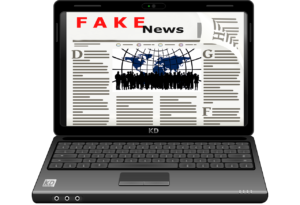
We all know that fake news is everywhere these days. It is in social media, news websites, even our email. It’s easy to feel overwhelmed by it all, but as educators, we’re in a great position to help our students develop the skills they need to navigate this digital age. The best way to do that? Digital literacy.
So, how can we teach digital literacy in the classroom? And how do we tie it to the subjects we teach? The resources this week were SO helpful! Let’s dive into how we can make digital literacy fun and an essential part of our lessons.
Why Digital Literacy is Crucial
In today’s world, students need the ability to sift through large amounts of digital content and figure out what’s credible. Fake news can easily spread, and students need the tools to recognize it.
Digital literacy is about teaching students how to:
- Question the source: Who’s behind this information? Is it trustworthy?
- Check the facts: Does this match up with other reliable sources?

Photo by StartupStockPhotos on Pixabay
- Think critically: Why was this information shared, and what impact could it have?
We can teach students to use a “smell test” to figure out if something is fake. If a story seems too outrageous to be true, it’s time to question it.
Incorporating Digital Literacy into the Grade 3/4 Curriculum
I have been subbing a lot in a grade ¾ classroom and might receive a temporary contract to finish the year in grade 3/4 . This made me think about how I can incorporate digital literacy into the Grade 3/4 curriculum. Here’s how it ties to different subjects:
A really important first step is where to find credible sources. Here is a list of credible sources in Canada.
This video is also really helpful and I think very important to share (I would probably simplify for grade 3/4).
1. English Language Arts:
Students are already practicing reading comprehension and critical thinking with stories, so why not extend that to digital texts?
- Compare Digital Texts: Have students read a short story and then compare it with an article or blog post. Teach them to ask questions like, “Who wrote this?” and “Why are they writing it?”
- Create Fake News: Students love a good challenge! Have them create their own “fake” news stories. Afterward, students can share their stories and discuss what made them fake.
This aligns perfectly with the NCTE Definition of Literacy in the Digital Age. The NCTE stresses that students should be able to critically evaluate texts in different formats, and this activity helps them practice that skill early on.
2. Social Studies:
In Social Studies, students learn about history and current events.
- Fact-Checking Activities: Present students with different news articles about the same event. Teach them how to check the facts using credible sources. Discuss how different news outlets might present events in different ways.
- Creating News Reports: Ask students to research a current event and present it as a news report. This helps them engage with the content and practice using reliable sources.
The Canadian School Libraries Journal article, “Developing Critical Literacies: What We Need to Know in a Fake News World”, emphasizes that students need to develop the skills to evaluate sources of information, which can be easily incorporated into Social Studies lessons.
3. Science:
In Science, students can be introduced to the idea of reliable scientific research and how information can sometimes be misrepresented.
- Evaluating Science News: Give students a piece of “science news” (it could be real or fake) and have them decide whether the information is trustworthy.
- Hands-on Activities: Have students conduct their own experiments or research and then present their findings to the class. They’ll learn the importance of using reliable, factual information in their reports.

Practical Activities for Teaching Digital Literacy
Now that we know how to tie digital literacy to various subjects, let’s look at some fun, hands-on activities for Grade 3/4 students:
1. Fake News Detective:
Create a “fake news” mystery for students to solve. Present them with several news articles, some real and some fake. Have them work in groups to identify which stories are trustworthy and which are not. They can use fact-checking websites.
2. Create a Digital News Report:
Have students create a news report on a topic of their choice. Encourage them to research the topic thoroughly and use credible sources. Then they can present their news report to the class.
Also online games like Spot the Troll and Can You Spot the Fake News Headline?
Conclusion
Digital literacy is an essential skill for students, even at a young age. By teaching students how to question sources, fact-check information, and think critically about the content they encounter, They’ll love the hands-on activities and challenges, and it will be helping them become informed digital citizens.

References
Brown, D. (2020, September 21). How to choose your news. TED-Ed. https://ed.ted.com/lessons/how-to-choose-your-news-damon-brown#watch
Canadian School Libraries. (2020, February 20). Developing critical literacies: What we need to know in a fake news world. Canadian School Libraries Journal. https://journal.canadianschoollibraries.ca/developing-critical-literacies-what-we-need-to-know-in-a-fake-news-world/
National Council of Teachers of English. (2013, November 7). NCTE’s definition of literacy in the digital age. National Council of Teachers of English. https://ncte.org/statement/nctes-definition-literacy-digital-age/
School Library Journal. (2017, February 15). The smell test: Educators can counter fake news with information literacy. School Library Journal. https://www.slj.com/story/the-smell-test-educators-can-counter-fake-news-with-information-literacy-heres-how
I really like how you broke it down by subject area for what you would do to teach internet safety. You clearly took a very detailed approach to analyzing the articles and applying them to how you would teach this in your classroom.
I am also interested in teaching grade 3/4 and I really love the way you explained this and broke it down. I am definitely going to take those practical activities and use them in the classroom one day!
I love how you included so many resources and so many subject areas! I also have an interest in grade 3/4 and this is super useful!